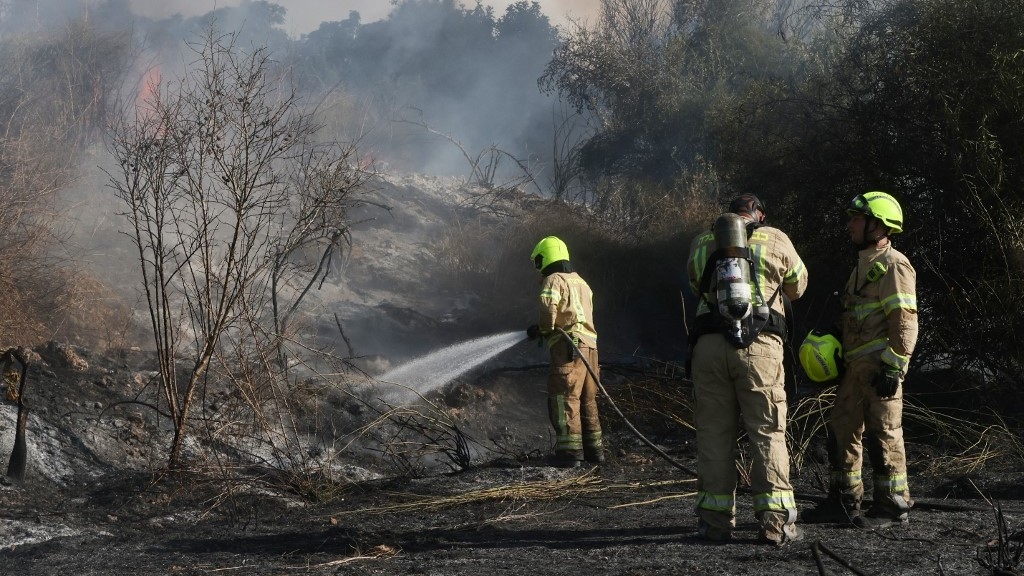Houthi 'hypersonic' missile attack on Israel: What we know so far

Yemen’s Houthis on Sunday claimed a ballistic missile attack that hit the centre of Israel.
The attack by the long-range missile sparked a fire but did not cause any direct casualties, according to the Israeli army.
The Houthis, who control most of Yemen and the capital Sanaa, said the missile was a hypersonic one. The Israeli military denied it was hypersonic.
The Iran-aligned group, officially known as Ansar Allah, have been launching attacks on Israeli-linked ships in the Red Sea since November, following Israel’s devastating military campaign against the Gaza Strip.
The Yemeni group says their attacks are in solidarity with Palestinians in Gaza.
New MEE newsletter: Jerusalem Dispatch
Sign up to get the latest insights and analysis on Israel-Palestine, alongside Turkey Unpacked and other MEE newsletters
Ansar Allah military spokesperson Yahya Saree said they had “targeted a military position of the Israeli enemy in the Jaffa area” with a “new hypersonic ballistic missile” that travelled 2,040 km (1270 miles) in just 11 1/2 minutes.
Houthi media said Israel’s defence system failed to intercept the missile.
“A Yemeni missile reached Israel after ’20 missiles failed to intercept’ it,” said Nasruddin Amer, the head of the Yemeni group's Sabaa news agency.
Meanwhile, Israeli Prime Minister Benjamin Netanyahu said the Houthis would pay a "heavy price" for the attack.
Hypersonic missiles travel much faster than traditional ballistic or cruise missiles, making them extremely difficult to detect, track, or intercept by current defence systems.
They travel at speeds greater than Mach 5, which is five times the speed of sound (approximately 3,800 miles per hour or 6,100 kilometres per hour).
Unlike ballistic missiles, which follow a predictable parabolic trajectory, hypersonic missiles can manoeuvre during flight, making them highly agile and harder to predict. This allows them to evade missile defence systems more effectively.
Additionally, hypersonic missiles can fly at lower altitudes compared to ballistic missiles, often in the upper atmosphere, which makes them harder to detect by radar systems designed to track higher altitude ballistic trajectories.
Several countries, particularly Russia and China, have been developing and deploying hypersonic missiles due to their speed and manoeuvrability.
It is not clear how the Houthis may have developed or acquired the missiles.
Iran’s president Masoud Pezeshkian on Monday said his country had not sent hypersonic missiles to the Yemeni group.
“We don't have such missiles to provide to Yemen," Pezeshkian said in a televised speech. But Iran last year showcased what it described as the country’s first Iranian-made hypersonic ballistic missile named "Fattah".
Little damage
Following the attack, air-raid sirens went off in central Israel, including in Tel Aviv and Ben Gurion International Airport, and many residents ran for shelter. The Israeli emergency services said that nine people sustained minor wounds while seeking shelter, but no other casualties have been reported.
Airport operations also resumed shortly after the attack, according to the airport authority.
“Following the sirens that sounded a short while ago in central Israel, a surface-to-surface missile was identified crossing into central Israel from the east and fell in an open area. No injuries were reported,” the Israeli military said.
Hamas welcomed Sunday’s attack, and said it considered it a “natural response to the Zionist entity’s aggression against our Palestinian people”. It added that Israel “will not enjoy security” until it ends the war on Gaza.
Sunday’s attack is the first by the Houthis to reach central Israel following their drone attack on Tel Aviv in July that killed one man and wounded four people.
The group also said it attacked ships at the Israeli port of Haifa in June, in addition to drones and missiles that it fired towards the southern Israeli port city of Eilat.
The Houthis have continued their Red Sea attacks despite a campaign by a US-led military coalition since January to repel them.
Middle East Eye delivers independent and unrivalled coverage and analysis of the Middle East, North Africa and beyond. To learn more about republishing this content and the associated fees, please fill out this form. More about MEE can be found here.





